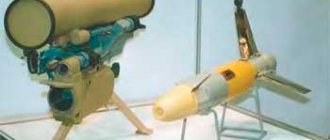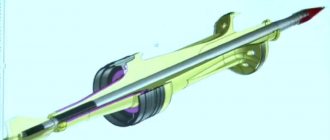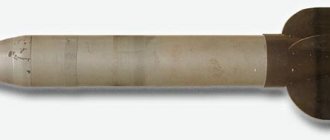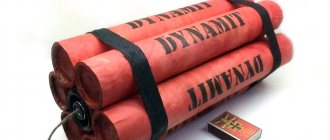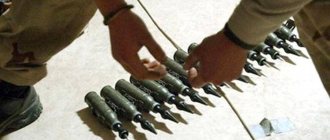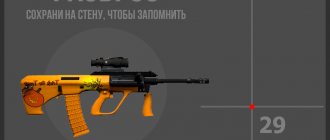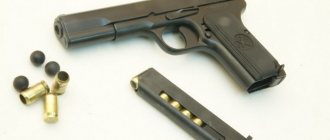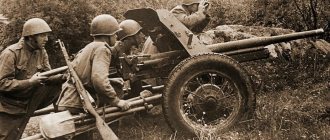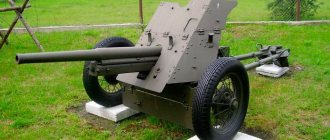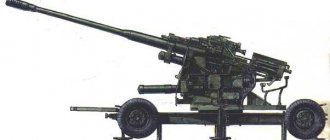New in blogs
The Tula Arms Plant has always been involved in the production of rifle systems, but in the 80s and 90s. XIX century he had to organize the production of high-speed small-caliber five-barreled Hotchkiss guns, which the Russian fleet desperately needed. By the mid-1870s. the development of pole mines and torpedoes required arming warships with rapid-fire small-caliber artillery. In this regard, during 1875–1885. To combat destroyers, the Russian Maritime Department purchased 35 four-barreled Palmkranz guns with a caliber of 24.5 mm, 61 single-barrel Engström guns with a caliber of 44.5 mm, and 37 four-barreled Nordenfeld guns with a caliber of 24.5 mm. Since 1878, the issue of adopting Hotchkiss's five-barreled revolver guns, which were produced in Paris, into service with our fleet has been considered. The 37-mm French cannon brought to St. Petersburg was tested on Volkovo Pole. There was, but the promised rate of fire of 60 - 80 rounds per minute in practice turned out to be significantly lower: 32 rounds per minute without aiming and only 20 with aimed shooting. Further tests, however, made it possible to conclude that the Hotchkiss gun is superior to the rapid-fire guns of other systems and “consider it useful to adopt the Hotchkiss gun-revolver into service with naval vessels for action against destroyers.”
But the Artillery Department of the Marine Technical Committee (JSC MTK), agreeing with the opinion of the commission, still continued testing naval guns. And only in 1880, tests of the Hotchkiss and Nordenfeld guns at the new naval training ground of the Okhtensky field finally revealed the advantages of the 37-mm Hotchkiss gun. After this, the purchase of guns began in France. Guns were purchased there not only with a caliber of 37, but also with 47 mm.
By January 1, 1886, the Navy Department had 197 37 mm and 15 47 mm Hotchkiss guns on ships and arsenals. On average, the price of one gun purchased abroad was about 6 thousand rubles.
The leaders of the Naval Department were well aware that the purchase of naval guns abroad made the Russian fleet completely dependent on foreign companies. And then a decision is made to manufacture in Russia “cannons with five rotating barrels to repel attacks by destroyers.” This meant the five-barreled 37 mm and 47 mm Hotchkiss guns. For 200 thousand francs, the right to produce these guns at domestic arms factories was purchased.
It was planned to organize the production of guns at the Imperial Tula Arms Plant (ITOZ) and the Obukhov Steel Foundry in St. Petersburg, a special enterprise for the production of ship steel artillery. This plant, according to the conclusion of the Naval Ministry, was “completely on par with the best of foreign cannon factories” and was a regular supplier to the Naval and Military Departments.
Why weapons factories other than Tula were not considered for the production of Hotchkiss guns cannot be said with certainty: there are no direct documentary sources. At that time, the factory produced rifles mod. 1870, according to many tactical and technical data, satisfying the then requirements of the army. Minister of War D.A. Milyutin believed that “it can be recognized as perhaps the most perfect of all hitherto known rapid-fire guns.” To produce these new weapons, it was necessary to deploy appropriate production capacities, for which it was created in 1870–1873. A major reconstruction of the plant was carried out. For the first time in its history, TOZ received the necessary amount of energy and technological equipment and production space in order to organize a full production cycle on it.
The comprehensive changes that took place at the plant not only made it the most advanced enterprise in Russia and Europe, but also created the prerequisites for organizing the production of the most complex weapons systems of that time. Hotchkiss's guns turned out to be just that.
What was also new and very important in the life of the plant was that the management staff - workshop heads and their assistants, weapons receivers, rejectors - was staffed not from among qualified but illiterate craftsmen - gunsmiths, as was the case before, but from qualified specialists - officers who had graduated St. Petersburg Mikhailovsky Artillery Academy, then the best military-technical educational institution in Europe.
One of these specialists was Captain Pyotr Nikiforovich Mikhailov, who, after graduating with the first category from the Mikhailov Academy, was sent in 1876 to serve at the TOZ and received the position of assistant to the head of the forge workshop. Very soon, the plant management paid attention to the young officer’s deep knowledge and broad outlook. Two years later, Captain Mikhailov headed the blacksmith shop, which he led for 11 years.
The ability to correctly assess current events and foresee their development, the extraordinary abilities of a leader - all this was noticed in the Main Artillery Directorate (GAU). Captain Mikhailov was sent more than once to other arms factories in Russia and abroad. So in the summer of 1881 he was sent to Izhevsk, where he studied the structure and operation of gas furnaces. Over the course of several months in 1884, Mikhailov, as a member of the commission, was present at the transfer of the Sestroretsk arms factory from commercial management to government management.
At the end of 1885, Captain Mikhailov was invited to St. Petersburg, where he and representatives of the Naval Ministry took part in a discussion of the issue of “the speedy and successful establishment of production in Russia of revolver guns for the Naval Department. We were talking about five-barreled Hotchkiss guns with a caliber of 37 mm and 47 mm. The GAU entrusted the preparatory work to Captain Mikhailov. By the highest order, communicated in the order of the GAU dated February 18, 1886, he was sent to France for a comprehensive study at this plant of the production of 47-mm five-barreled Hotchkiss revolver guns. Meanwhile, already on February 25, such a French-made cannon and a stand and swivel were sent from Kronstadt to Tula to familiarize themselves with the new model.
Captain Mikhailov’s report dated May 7, 1886, sent from Paris to the head of the ITOZ, it follows that, in addition to him, factory craftsmen should also become familiar with the production of guns. This, he believed, would facilitate the installation of cannon manufacturing in Tula and provide the opportunity to have its own qualified personnel. It was decided that toolmakers and masters of drilling and cutting trunks would go to Paris.
Passports for travel to Paris, issued by the Tula governor, Privy Councilor S.P. Ushakov, received by gunsmiths V. Sinopalnikov, A. Sonin, I. Nozhevnikov, I. Shpanov.
A contract was concluded with the craftsmen, according to which they were given from 50 to 100 rubles for clothes; the salary was determined to be the same as what was paid at the factory. The qualifications of the craftsmen were taken into account. If the terms of the contract were not fulfilled (bad behavior, poor quality work, etc.), then Captain Mikhailov had the right to deprive the seconded of part of the money due to them.
From Tula the masters went to St. Petersburg, from there to Paris they were accompanied by Staff Captain Vasiliev, who was to be the receiver of Hotchkiss guns at the arms factory in Tula from the Naval Department. All expenses for the stay of the craftsmen abroad were later reimbursed to the plant by the Main Directorate of Shipbuilding and Supply.
The device of a five-barreled gun
FIVE BARRELS WERE LOCATED AROUND A ROTATING SHAFT. THE MAIN MECHANISM WAS A CAST WHEEL PLACED ON A HORIZONTAL AXIS, PERPENDICULAR TO THE BARREL AXIS. THE LEFT PART OF THE WHEEL ROTATED THE BARREL SYSTEM, AND THE RIGHT PART FIRED THE SHOT. THE ROTATION OF THE WHEEL AND, THEREFORE, THE SHOOTING WAS DONE BY ROTATING THE HANDLE, WHICH FIRST ROTATED THE BARRANKS BY 1/5 OF A CIRCLE. AT THIS WAY, THE CASE EXTRACTION OCCURRED, AND A PROJECTILE WAS PUSHED FROM THE RECEIVER ABOUT 4/5 OF ITS LENGTH INTO THE CHAMBER OF THE NEXT BARREL. WITH FURTHER ROTATION OF THE HANDLE, THE PROJECTILE WAS REACHED TO THE PLACE AND THE SHAKER WAS COCKED, AND NEW AMMUNITION FELL FROM THE FEEDER INTO THE OPEN RECEIVER UNDER THE INFLUENCE OF THE WEIGHT OF THE PROJECTILES LYING ON IT. AT THIS TIME, THE TRUNKS AGAIN ROTATED BY 1/5 OF A CIRCLE. THEN, WITH THE ROTATION OF THE HANDLE, ANOTHER TURN OCCURRED AND A SHOT WAS FIRED. THUS, WITH EACH ROTATION OF THE HANDLE, ONE SHOT OCCURRED, AND THE BARREL MADE FIVE INTERMITTENT ROTATIONS, AND THE PROJECTILE THAT ENTERED THE RECEIVER WAS SHOOTED AFTER THE THIRD TURN, AND THE CASE WAS THROWN BETWEEN THE FOURS THE FIRTH AND THE FIFTH.
Arriving in Paris, the Tula residents began work on the second day. Nozhevnikov studied drilling and cutting barrels, making shells, Sonin studied all the transitions of turning work. They made all the patterns according to the existing samples. Shpanov and Sinopalnikov had to master the debugging and assembly of guns. During the first months, Tula craftsmen worked together with French specialists. Then on their own, and “they did not spoil a single thing, despite the news of the case.” Their high skill, hard work, and behavior earned them universal respect. Captain Mikhailov, while in Paris, was busy placing orders for the equipment necessary for the production of Hotchkiss guns. The representative of the Main Directorate of Shipbuilding and Supply of the Naval Ministry, Major General Yanovsky, also in Paris, asked the head of the ITOZ, Major General Bestuzhev-Ryumin, to send a plan of the premises where the production of Hotchkiss guns would be located. This was also the requirement of the Hotchkiss company. However, on, which before shipment were tested at the Hotchkiss plant in the presence of Captain Mikhailov. The machines and devices were believed to be intended for the annual production of 40 guns of 47 and 37 mm caliber.
We also bought machines for the Cannon Workshop in Russia: lathes from the Schaeffer and Budenberg plants, . The assistant to the head of the plant, Colonel Shekarazin, reported to the Naval Ministry about the purchase of two Ioganson lathes at a price of 725 rubles apiece. The Vasilyevsky cartridge department of the St. Petersburg cartridge plant supplied seven lathes to the arms factory. At the request of Captain Mikhailov, blocks with chains were delivered from Moscow for lifting parts of the guns during assembly. The plant was offered machines and devices from Kesler and Weichelt.
By the end of 1886, the masters of the arms factory also returned to Tula. Staff Captain Vasiliev admitted that “they have perfectly mastered the new production and can independently conduct it in Tula.” This assessment was objective, since Shpanov and Sinopalnikov produced two guns at the Hotchkiss factory - No. 64 and No. 65 - truly on their own. The gun No. 64 with a caliber of 47 mm was sent to Tula as an exemplary one. There was an inscription on it in Russian: “A gun made by Tula craftsmen at the Hotchkiss factory in Saint-Denis in 1885.”
Ivan Nozhevnikov became a good specialist in drilling, sharpening and cutting barrels, and in addition, in the cartridge shop he became acquainted with cartridge case production, which also had to be established at the plant. The artisans who worked in France became good assistants to P.N. Mikhailov, who was to head the production of Hotchkiss guns, as evidenced by the following documents. From Circular No. 42 of the Maritime Department to the head of the ITOZ dated January 20, 1887: “... in view of the fact that some of the machines for making Hotchkiss guns have already been delivered to the plant, I propose that Your Highness order the establishment of a special workshop called Cannon and entrust the leadership of this workshop to Captain Mikhailov.” ; the head of the ITOZ, Major General Bestuzhev-Ryumin, already on January 26, 1887. almost repeats the text of the circular: “... to dispose of the establishment of a special workshop called Cannon and to entrust the management of this workshop to Captain Mikhailov, who at the same time will remain the head of the forge workshop.”
The production of guns at the plant was established with great difficulty. For a long time there was a shortage of some equipment that had not previously been purchased in France; it was necessary to train workers to perform various operations on the new machines. In addition, it was discovered that the patterns, instruments, calibers sent by Major General Yanovsky from Paris were without numbers, without designations - this made it impossible to use them. Yanovsky also did not send the rod to the roller-cone machine (it was later sent by Staff Captain Vasilyev).
The Naval Ministry instructed the head of the ITOZ to build a one-story extension to one of the factory buildings for painting steel shells that were to be manufactured at the factory. But in order to avoid spending three thousand rubles on construction, they decided to hand over the shells “without painting, but covering them with drying oil.” In 1889, the receiver, Staff Captain Vasiliev, nevertheless achieved the construction of a special building where the shells were painted.
There were also difficulties with constructing a trench for testing guns, the construction of which required a large number of steel sheets. In order not to waste money, the construction committee of the Maritime Ministry proposed using sheets located in the St. Petersburg seaport. But the design of the trench made by the factory architect (they wanted it to be like at the Hotchkiss factory) turned out to be very expensive and then they decided: “... there will be only a few guns, so they won’t try it every year or even all day,” and therefore they completely abandoned the project. We decided that we could use the shooting range, but if there were any expenses, they would be insignificant. This information was obtained from the “Journal of the Construction Committee of the Naval Ministry” dated March 20, 1887.
The trench was still made at the shooting range, but testing of the first 47-mm cannon, manufactured in the Cannon Workshop on June 2, 1887, revealed many shortcomings in the design of the trench, one might say, its unsuitability for testing. In this regard, Staff Captain Vasiliev considered it necessary to test the first guns with the naval battery of the Okhtensky Field. The first 47-mm gun successfully passed tests and was sent to the St. Petersburg port office.
From the Obukhov plant, at the request of the receiver, instead of blanks, from August 1887 they sent “roughly drilled” barrels. Captain Mikhailov and master Ivan Nozhevnikov went to the Obukhov plant to “get acquainted with the methods of hardening and processing techniques for high-resistance steel.”
By the way, Captain Mikhailov highly valued the craftsmen who worked with him in Paris, and more than others, who helped him establish the production of cannons in Tula. At the request of Captain Mikhailov, GUKiS considered it possible to increase Nozhevnikov’s monthly payment to 75 rubles. in exchange for 1 rub. 70 kopecks per day with 10 working hours; I. Shpanov and V. Sinopalnikov - 55 rubles. in exchange for 1 rub. 50 kopecks per day with 10 working hours. In 1888, the question arose about the production of five-barreled Hotchkiss guns with a caliber of 37 mm in the Cannon Workshop, but with the sending of such a gun as an exemplary one they were slow: a 37-mm gun “bronzed, with parts of the mechanism, sights and front sights installed in place, as well as swivels, walnut butts with rubber linings, feeders for pouring cartridges into the gun” were received only at the end of 1888 from the St. Petersburg port. But there were no drawings, other than those that Captain Mikhailov and Staff Captain Vasiliev had prudently brought from Paris.
In 1888, 10 guns of 47 mm caliber were manufactured with accessories: two guns were sent to the St. Petersburg port, eight guns were sent to the ship Sinop in Sevastopol. This quantity, of course, was not enough; by the summer of 1889, it was necessary to increase the production of 47 mm guns by 10 - 15 units, and to produce at least 20 units of 37 mm guns by the end of the year.
The situation with the supply of steel for the manufacture of shells was also difficult. So, 102 pounds of steel for 37-mm shells were received from the Izhora factories, and all of it turned out to be unusable. With permission from the Maritime Ministry, the steel was sent back. As proof of the unsuitability of the steel, they sent three projectiles (unhardened, hardened and hardened with strong heating), on which cracks and “deep hairs” were found, and the projectiles, when tested with a saw, still turned out to be soft. At ITOZ, the quality of hardening was determined in different ways: puncture with a saw, scribers, and the blow of a falling hammer of a certain weight.
The Naval Ministry recommended again taking crucible steel from the Obukhov plant and trying to use open-hearth steel (it is cheaper). It was known that shells were then made from open-hearth steel at the Baranovsky plant, which purchased it from the private Aleksandrovsky plant.
It was decided not to experiment, but to use steel from the Obukhov plant. However, deliveries were irregular: for 10 days in October 1889, the machines for making shells were idle. The head of the Cannon Workshop, Captain Mikhailov, asked the head of the plant, through the Naval Ministry, to demand regular supplies of two hundred pounds of steel per month from the Obukhov plant.
With whom there were no problems, it was with the private cartridge supply that the Cannon Workshop supplied shell casings and capsules with sockets for the casings. However, there are often documents addressed to the economic department of TOZ: “... the cartridge factory asks to pay for equipment... cartridges for 37-mm and 47-mm Hotchkiss guns,” which gives the right to assume that payment was made irregularly.
At the same time, the cost of guns and shells for them was calculated clearly, month by month and year by year. It consisted of the cost of basic materials and wages, a percentage of the total costs for the workshops, and separately for the plant.
So the cost of a 47-mm cannon manufactured at ITOZ in 1893 is 1915 rubles. 40,945 kopecks — was made up of the cost of basic materials 696 rubles. 75,875 kopecks; wages - 571 rubles. 83,625 kopecks; interest on total expenses for workshops amounted to 228 rubles. 39,170 kopecks, at the factory - 418 rubles. 42,275 kopecks The difference in price is due to the following reasons:
◦cost of barrels in 1888, 1889, 1890 was 465 rubles, since 1891 - 121 rubles; ◦defects took place not only in small bronze parts, but also in large ones, the volume of which amounted to 75% of all bronze for the cannon; ◦ it was taken into account at which transition - the first or the last - defects were allowed; if at the last, then in this case up to 40% of the bronze turned into chips. In 1895, the price of guns increased again due to the small volume of their production: 10 pieces. In addition, defective barrels were stored in the workshop in case guns were made from substandard parts, but in 1895 there were no orders for such guns, and the barrels were put into storage as unnecessary, which also increased the cost of the guns.
A 37-mm cannon, manufactured in 1893, cost 1,484 rubles. 58,135 kopecks Materials - 594 rub. 86,318 kopecks; 400 rubles were spent on labor costs. 70,010 kopecks; interest on total expenses for workshops amounted to 164 rubles. 71,007 kopecks, at the factory - 324 rubles. 30,800 kopecks.
In 1888, 37-mm cannons and shells for them were not manufactured, and the difference in price was due to the fact that previously rejected parts were used in their production. Let us calculate, for example, the cost of a shell for a 47 mm cannon. In 1893 it turned out to be equal - 3 rubles. 8,712 kopecks; 1 ruble was spent on materials. 91,838 kopecks; salary - 0 rub. 38,364 kopecks; interest on total expenses for workshops - 0 rub. 16,731 kopecks, at the factory - 0 rubles. 61,809 kopecks.
In 1888 and 1890 the price was high because a lot of defects were allowed: in 1889 - 5.88%, in 1890 - up to 8%. The steel supplied by the Obukhov plant was not always of good quality. The results of chemical analyzes of three ammunition showed the carbon content in the 1st projectile - 0.25%, in the 2nd - 0.55%, in the 3rd - 0.62%. Staff Captain Vasiliev repeatedly asked steel suppliers to ensure that the metal was homogeneous, with an average carbon content of 0.55%.
In 1893 - 1895 the cost of shells is decreasing, primarily due to the improvement in the quality of seals (defects in 1895 amounted to 2%), shock tubes became cheaper: 27 kopecks. instead of 39 kopecks. in 1889 - 1891
Information on the cost of guns and shells in 1896 was not found, but a curious document dated July 16, 1896, signed no longer by Captain Mikhailov, who became the head of the Tool Workshop instead of S.I. Mosin, and by Staff Captain Kupriyanov, appointed head of the Cannon Workshop: “... in the workshop entrusted to me, one 37 mm gun No. 251 was fixed, inspected by a receiver from the Naval Ministry and delivered to the store, sealed in 3 boxes.” The fix consisted of replacing two barrels, a hammer and a frame. The cost of the gun was 3076 rubles. 40 kopecks, and the cost of correction without workshop and factory costs is 255 rubles. 43 kopecks
It should be noted that the strictness in the acceptance of ready-made guns and shells by Staff Captain Vasiliev was beneficial to the cause. For 1889–1896 Only two guns were returned to the factory. Vasiliev’s energy, organizational talent, his deepest knowledge of technological processes and the qualities of steel are truly admirable.
In August 1896, 37-mm cannons were delivered to Staff Captain Vasiliev - 4 units and 90 thousand shells. These were the last guns ordered back in 1895.
It was for this task that the head of the ITO asked the Maritime Ministry to allocate an additional loan in the amount of 39,853 rubles. and another 6500 rubles. for the repair of all machines so that “they are in good working order” upon completion of all work in the Cannon Workshop.
The plant manager was also concerned about the future fate of the workshop: whether there would be new orders for the production of single-barreled Hotchkiss guns, which had already been produced at the Obukhov plant since January 1896; is it possible to produce 37 mm Maxim automatic guns; what to do with workers and specialists if the workshop is closed.
By the end of July 1896, all work on the delivery of shells and guns at the plant was practically completed, with the exception of fitting and finishing parts for the last three 37-mm guns. As follows from the report of the new receiver at the ITOZ, Colonel Levitsky, to the Naval Ministry, they will be presented for reception no earlier than August 15. The guns were indeed delivered on August 15, 1896.
It was then that the Ministry of the Navy indicated: “... upon completion of the orders for 37-mm and 47-mm five-barreled Hotchkiss guns already submitted by ITOZ, no more guns will be produced for the fleet.”
Thus, it is already possible to sum up the activities of the Cannon Workshop at the Tula Arms Plant: 296 guns of 37 mm caliber and 42 guns of 47 mm caliber, about 490 thousand shells for them.
Unfortunately, the assumption of producing 40 guns annually did not come true. They did not take into account the “novelty of the matter,” and most importantly, that for the plant this production was, perhaps, honorable, but burdensome, because tests were underway, and then the production of a 3-line rifle mod. 1891, the main products of the enterprise.
Despite this, the order of the Maritime Ministry on the transfer of all machines belonging to the Maritime Department to artillery workshops in the ports, as well as another instruction - “to dispose of the metals and materials remaining at the ITOZ from the manufacture of Hotchkiss guns and shells for them were clearly carried out. The plant auctioned off various materials from the Cannon Workshop, and the proceeds were included in the fifth item of the Navy Ministry's revenue estimates.
Noteworthy is the excellent organization of the reporting system: written instructions regarding the use of amounts released by the Maritime Ministry; reports on every ruble and kopeck used - to the Main Directorate of Shipbuilding and Supply, on the release of guns and shells - to the Artillery Department of the MTK.
Five-barrel Hotchkiss guns with a caliber of 37 mm and 47 mm, manufactured in the Cannon Workshop at the arms factory in Tula, were thoroughly tested on ships of the Baltic and Black Sea fleets and became part of their armament. This is undoubtedly the merit of Tula gunsmiths.
yaRNAKERHE OPNKN YAN BPELEM ANEB 1-I lHPNBNI BNIMSH. hLEMMN RE TSPNGMSHE TsNDSH MYUVYUKYU 20-TSN BEYU YARYUKH GMUYINBSHLH B YARPELHREKEMNL OPNTSPEYAYAYE BNEMMNI REUMHYH. oPYURHVEYAYH BYA╦, VRN DN YAKHU ONP YANYARYUBKER BNEMMSCH LNYE TSNYASDYUPYARB, ASHKN PYUGPYUANRYUMN, HYAOSHRYUMN H OPHLEMEMN B 1-L DEYARHKERKHH OPNKNTSN BEYU. rYUMYKH YUBRNLNAKHKKH, YAYNPNYARPEKEMYU YUPRHKKEPKH KH YUBRNLYURKHVEYAYNE NPSFHE, YUBHYUMNYAZHSH KONDBNDMSHE KNDYKH, √ BYA SCHRN OKNDSH KHMFEMEPNB RNCN BPELEMKH.nRMNYAHREKEMN ANEBNI YUBHYUZHKH, RN NYAMNBMSHE YKYUYAYASH ANEBSHU LYUHM, B ANKEHMYARBE YABNEL YASYYYARBSCHYKHE DN YAKHU ONP, RUYFE YATNPLHPNBYUKHYAE MU PSAEFE 1915 √ 1916 , NDMUYN ONOSHRYKH SYARYUMNBYKH BNNPSFEMKH MU YUSCHPNOKYUMSH ASHKKH OPEDOPKHMIRSH GMYUVHREKEMN PUMEYE. b YANGMYUMXX NASHBUREK OPNVMN SYNPEMKHKNYAE LMEMKHE, VRN B MYUVYUKEMNL OEPKHNDE 1 lHPNBNI BNIMSH YUBHYURNPSH OPNRKHBNANPPYARBSCHYHU YARNPNM HYAONKEGNBUKH B BNGDSUE PEBNKEBEPSH X YYUPYUAHMSH, RYUPYUMHKH DPTS DPSTSYU, X KKHE ONGDMEE MYUVYUKH OPHLEMERE OSKELERSH, YUY DK NANPNMSH, RYU KH DK MYOOYUDEMKH. yu BNR OSEVMNE BNNPSFEMKHE, YUY OPYUBHKN, YUYAYANZHKHPSERYA I ANKEE ONGDMHL OEPKHNDNL.
REL ME LEMEE, SHRN ME YANBYAEL RYU. eYE B 1910 TsNDS MU OYUPKhFYAYNI BSHYARYUBYE YUBKHYUZHNMMNTSN RPYUMYAONPRY APYUREALH tsYuAPHSHCHKEL H YUPKEL bSYUGEMYULH ASHKYU OPEDYARYUBKEMYU LNDEKE YUSCHPNOKYUMYU B MNYANBNI VYUYARKH YNRNP NTSN ASHKN YALNMRKHPNBUMN DNBNKEMN-RUYKH BMSHREKEMNE ON PUGLEPYUL NPSDHE, YNRNPNE OPEDYARYUBKKKN YANANI, OPYUBDU, DPNANBKHY LYUMSTYU (canardière canon de la Manuf) DK NUNRSH MU ORHJ. bПЪД КХ АПУРЭЪ bСУГЭМ ХЛЭХ B БХДС МЭВРН АКеее, ВEL PEYKYULS, SYARYUMYUBKHBYU TSKHTSYUMRYAYNE NUNRMHVEE PSFEE MU NDMS HG OEPBSHU YABNKHU YNMYARPSYZHKHI. mN, REL ME LEMEEE, ON-BHDHLNLS, PEIKULYU "BSHYARPEKHKYU", H YNLS-RN HG BNEMMSHU GYUOYUKYU B DSS. pJD KHYARNVMKHYNB SONLKHMYUCHR NOSHR I SYARYUMNBYNI OSYKH TsNVYHYA MY YUSCHPNOKYUME AKEPHN XI B 1912 TsNDS, MN, OH BYAEI BKHDHLNYARKH, SHRYU KHMTNPLYUZHKH NKHANVMYU, OPNKHGPYUYA RYUCHYU HG NANGMYUVEMH NDMNI HG LNDEKEY YAYULNKERYU "Bleriot-XI Artillerie", TsDE REPLHM "yuPRHKKEPKH" NANGMYUVUER ME MYUKHVKHE MU MEL OSYKH, YU OPKHMYUDKEFMNYARE Y PNDS BNIYAY. oEPBSHI GYUDNYSLEMRKHPNBYUMMSHI NOSHR OPHLEMEMH TPYUMZHSGYULH OSYKH B BNGDSUE I YUSCHPNOKYUMYU bSYUGEM III OPNKHGNYEK B KHCHME 1914 TsNDYu AKHG TsNPNDYU hyYAKH-KE-lSKHMN. b OEPEDMEI YUAHME bSYUGEMYU ASHKYU YALNMRKHPNBYUMYU YNPNRYNYARBNKEMYU OSYU TsNVYHYA YUKHAPU 37 LL. bOPNVEL, XIAOEU OSEVMNI YARPEKEASH I YAYULNKERYU ASHK NRMNYAHREKEMSHL. xG-GYU MEAPEFMNYARH MYUBNDVKHYU ASHK OPNKHGBEDEM YAKSVYUIMSHI BSHIARPEK, B PEGSKERYURE YNRNPNTsN 37-LL YAMYUPD STSNDHK B TEPLEPYAIKHI DNL, Y YAVYUYARECH AEG FEPRB.
хЯОШРУМХЪ BNNPSFFEMMSHU OSYULKH YUSCHPNOKYUMNB bSYUGEM RHO LA X LAS OPNDNKFYUKHYAE DN YNMZHYU 1914 TSNDYU, YU B YUOPEKE YAKEDSCHYETSN, 1915, ASHKH YATNPLHPNBYUMSH OEPBSHE YUBHYUNRP ЪДШ, BNNPSFEMMSHE OSEVMSHLH bSYUGEMYULH - SAC 6 X 7 (Sections d'avions-canons), ONGDMEE NAZEDHMEMMSHE B SHCHAYYUDPHKECH V 113 ; SAC 5, 8, 9, NAZEDHMEMMSHE B SHYAYYUDPHKECH VB 111. th NYRAPCH 1915 TSNDYu YATNPLHPNBYUKH DNONKMHREKEMSHE RPH OSEVMSHU YUBHYUNRPYU SAC 12, 13 X 14, NAZEDHMEMMSHU B SHYAYUDPHKECH VC 116. bNNPSFEMKHE SHHRKHU NRPЪDNB YANYARYUBKKKH bSYUGEMSH LNDEKEY RHO 5, DPSTSNE NANGMYUVEMHE - RHO LAS, YU RUYFE bSYUGEM RHO 4 X bSYUGEM VIII. yu BNR I SYARYUMYUBKHBUELSHHLH MU YAYULNKERYU OSYULH EYARE MEINRNPUY OSRYUMKHJYU.
ShYYAOEPR B NAKYUYARKH YARPEKYNBNTSN NPSFKH ANEOKHOYYANB schMRNMH sHKELYA B PJDE YABNHU PYUAR SRBEPFDUER, VRN YASYYARBNBUKN DBY RHOYU 37-LL AXIS, SYARYUMYUBKHBUELSHU M YU TPYUMZHSGYAIKHU OSEVMSHU bSYUGEMYU √ ShRN YNPNRYNYARBNKEMYU YAYNPNYARPEKEMYU OSYU TsNVYHYAYU LNDEKH 1885 TsNDYU OND OURRPNM 37U94R X DKHMMNYARBNKEMYYA SYAK NBMSHL NANGMYUVEMHEL “Tube canon” LNDEKE 1902 TSNDYU, HYAONKEGSELYU MU TKNRE DK YARBNKKHYNBNI YARPEKEASH B YPSOMNYUKHAEPMSHU NPSDHU. ShchYu OSYU HYAONKEGNBUKYU ANKEE LNYMSHE OYURPNMSH 37U201R. schryu KhMTNPLYUZHH LMNTsNYPYURMN RPYUMYAKHPPNBUKYUYAE HG HYARNVMHYU B HYARNVMHY, BOPNVEL, ME OPHAYUBK YNMYPERKHYKH Y BNOPNYAS. gMYUVHREKEMN ANKEE ONDPNAMN KHYARNPKH PUGPYUANRYH OEPBSHU TPYUMZHSGAYKHU YUBKHYUSYE NOKHYASHBUERYA B LYUYARYUAMNI 4-RNLMNI LNMNTSPYUTKHH pNAEPRY LEKKHYULOYU (Robert Mellichamp “A Gun For All Nations” The 37mm Gun & Ammunition", 2012).
ONEBKEMKHE YAYNPNYARPEKEMNI OSYKH TSNVYHYA ASHKN PEGSKERYURNL FEKYUMKH ONKSVKHRE ANKEE KETSYNE, YNLOYURMNE, REUMNKNTSKHVMNE H, YANNRBERYARBEMMN, DEEBNE NPSFHE, VEL 37 -LL PEBNKEBEPMYU 5-YARBNKEMYU LHRPYUKEEGYU RNI FE YNLOYUMHH. oEPBSHI NOSHRMSHI NAPYUGEZH YNMZHEORYU YAYNPNYARPEKEMNI NDMNYARBNKEMNI OSYKH ASHK PYUGPYUANRYUM B 1871 TsNDS aEMDFHYULHMNL TsNVYHYAYANL H KECHKHYANL aPNDBECKNL, OPEDYARYUBK YANANI NDHM YARBNK I YULNPNI DKHMNI 739 LL NR RNTSDU EY NOSHRMNI PEBNKEBPMNI OSYKH OND RNR FE YAYULSHI SMKHRYUPMSHI OYURPNM 37U94R. b OSYE ASHK OPHLEMEM BEPRHYUKEMSHI YKKHMNBNI GYURBNP. oEPBSHI BYUPHYUMR NPSDKH OPEDYARYUBKK YANANI ME ANKEE, VEL NOSHRMSHI REYARNBSHI NAPYUGEZH ME OPEDMYUGMYUVYUKYA DK PEYUKEMNTSN HYAONKEGNBUMH.
y 1878 TsNDS ASHK OPEDYARYUBKEM OEPBSHI YNLLEPVEYAYKHI NAPUGEZH 37-LL YAYNPNYARPEKEMNI OSYKH TsNVYHYA I BEPRKHYUKEMSHL YKHMNBSHL GYURBNPNNL, YARPEKBIEI 1-TSMRNBSHL YAMYUPDNL. b YABNEI PUANRE LEKKHYULO OHYER, VRN OEPBSH NAPUGZHS OSYKH KHLEKH SYNPNVEMMSHI ON YAPYUBMEMHCH I 20-YUKHAEPMNI PEBNKEBEPMNI OSYNI YARBNK I GUKHLARBNBUMMNI YULNPNI, MN ME SRN VMER, YYUNBYU ASHKYU DKHMYU YARBNKYU.
th YAEPEDHME 80-U TsNDNB 19 BEYU OSYU TSNVYHYAYA ASHKYU OPKHMRYYU MU BNNPSFEMHH TPYUMZHSGAYNTSN TKNRYU, ONKSVHB NANGMYUVEMHE “Canon de 37mm TR L/20 Mle 1885”, TsDE OND ASYBYULH рR YAYPSHBUKYUYAE YAAPEBHYURSPYU “tir rapide” - YAYNPNYARPEKEMYU. OSYU OPEDYARYUBKYU YANANI YNBUMSHI XG ZHEKEMNTSN YSYAYU YARYUKH YARBNK DKHMNI 740 LL HKH 20 YUKHAPNB, MYUPEGMYU VYUARE YANYARYUBKYU 627 LL √ 12 KEBNYARNPN MMKHU MYUPEGNB I STSKNL 6 TsPUDSYANB. I LOVE YARBNKYU ME OPEBSHYUKYU 14 YTS. y YARBNKS MU PEGEAE YPEOHKYUYAE YUGEMMYU VYUARE I BEPRHYUKEMSHL YKHMNBSHL GYURBNPNL, PSYNRYNI GYURBNPYU OND OPYUBSC PSYS, OKHYARNKERMNI PSYNYRYNI YAN YAOSYAINBSHL Y PCHVYNL X OPHYKYUDNL. NAYYU LYUYAYU RIVER NPSDKH ME OPEBSHYUKYU 33 YTS, VRN ONGBNKKKN HYAONKEGNBURE OSYS DUFE MU YUREPYU I OPHLHRHBMSHU YARYUMYNB YPSTSNBNTSN NAYARPEKYU. bBKhDS OPHLEMEMH DNYARYURNVMN LYUKNLNYMNTSN OYURPNMY, MKHYUYKHU NRYYURMSHU SYARPNIYARB B OSYE OPEDSYALNRPEMN ME ASHKN, BYACH NRDYUVS OPKHMKHLYUK MY YAEA YARYUMNY. MU LNPYAYNL RSLANBNL YARYUMYE ASHKN OPEDSYALNRPEMN YUPMKHPMNE OPNRKHBNRYURMNE SYARPNIYARBN.
OSYU NYUGYUKYUYAE MYUYARNKEIN SDYUVMNI H YNLLEPVEYAYH SYAOEMNI, VRN Y MYUVYUKS 20-TSN BEYU ASHKN YAKNFMN MYUGBYURE YPLXX LHPYU, B YNRNPSHU 1-TSMRNBSH TSNVYHYAYASH ME YANYAR NYKKH ASH MU BNNPSPHEMXX. lMNTSKHE YARPYUMSH ONYSOYUKH KKHZHEMGHKH MU OPNKHGBNDYARBN TSNVYHYAANB, PYUGPYUAYURSHBUKH MU EE NYAMNBE YABNKH BEPYAHH I PUGMSHLH DKKHMYULH YARBNKYU, YABNEI MNLEMYURSPNI ANEOPHOYU YANB. YNKKHVEYARBN PUGKKHVMSHU LNPYAYKHU X OUNRMSHU YARYUMINB, MU YNRNPNI ShchRKH OSYKH LNMRKHPNBUKKHYAE, BNNAYE RPEASER NRDEKEMNTSN HYAYAKEDNBYUMHЪ, MU YARNKEIN NMH ASHKH PUGMNNAP YUGMSH.
bN tPYUMZHKH PUGKKHVMSHE YASALNDKHTHYUZHKH AYUGNBNI YNMYARPSYZHKH 1-TSMRNBNI 20-YUKHAEPMNI OSYKH B GYUBKHYAHLNYARKH NR OPHLEMYELSHU YARYUMYNB, OPKHZHEKNB X BMEMEI NABUG YH NANGMYUVYUKHYAE BBEDEMHEL DNONKMHREKEMNI LNDEKH. MUOPHLEP "Canon de 37mm TR L/20 Mle 1885 mod.98".
oNLHLN MYKHANKEE PYYAOPNYARPUMEMMNI AYUGNBNI LNDEKH I DKHMNI YARBNKYU 20 YUKHAPNB TsNVYHYA BSHOSYAYUK, TsKYUBMSHL NAPUGNL, MU SHYYAONPR EYE 23 X 27 YUKHAEPMSHE LNDEKH. b 1895 TsNDS MU BNNPSFEMKHE TPYUMZHSGYAYNTSN TKNRYU ASHKYU OPKHMYRYU LNDEKE 37-LL TsNVYHYAYU I DKHMNI YARBNKYU 35 YUKHAPNB, HYAONKEGNBUYUJU RNR FE OYURPNM 37U94R. ANKEE DKKHMMSHI YARBNK OPH MEHGLEMMNL ANEOPHOYUYAE ONGBNKKHK ONDMIRE MYUVYUKEMSCH YAYNPNYARE YAMYUPDUYU I HYAUNDMSHU 390-415 L/YA DN 550 L/YA. LYuYAYAYU, OPH SCHRNL, EYAREYARBEMMN, MEYAYNKEIN ONDPNYAKYU DN 58.5 YTS. schryu BEPYAKH ONKSVHKYU NANGMYUVEMHE “Canon de 37mm TR L/35 Leger Mle 1885” - “DKKHMMYU”, Yu 20-YUKHAEPMYU ANKEE YARYUPYU BEPYAKH OPH SCHRNL ASHKYU OEPENANGMYUVEMYU “Canon de 3 7mm TR L/20 Court Mle 1885" - "YNPNRYU". mu SHYAONPR RUYFE BSHOSYAYUKYUYAE 40-YUKHAEPMYU BEPYAH.
b 1883 TsNDS SDYuVMSCH YNMYARPSYZHCH YALYUYARYUAHPNBUKH, OPEDYARYUBKHB MU PSHMNY RUYFE X 40, 47 X 57-LL BEPYAHH AXLES. eYAKKH 40-LL BEPYAKH NYANANTSN PUYAOPNYARPYUMEMEMKH ME ONKSVKHKYU, RN 47-LL 3-TSMRNBUYU OSYU DKHMNI YARBNKYU 40 YUKHAPNB “Canon de 47 mm TR Modèle 1885” OND OYURPNM 47 x131R, X 57-LL 6-TSMRNBYU I DKHMNI YARBNKYU 40 YUKHAPNB “Canon de 57 mm TR Modèle 1885" OND OYURPNM 57x307R NYYUGYUKKHYAE ME LEMEE PUYAOPNYARPYUMEMMSHLH NPSDHILH, VEL 37-LL BEPIAHH, X RUYFE MYUDNKTSN SINPEMHKHKHYAE B DEYARYUU YUPLKHI LH PYU B YAYULSHU PYUGMSHU LNDHTHYUZHHU.
OSIKH TsNVYHYAYU NYUGYUKHYAE MU LNLEMR YABNETSN YANGDYUMH ON KHYARHME PEBNKCHZHNMMSHHLH. UNPNN RPEMKHPNBUMMSHY PUYAVER LNTs BEYARKH NTsNME I REUMHVEYAYNI YAYNPNYARPEKEMNYARECH DN 30 BSHYARPEKNB B LHMSRS. Byae ShRN ONGBNKKHKN ShRHL OSYUL YARYURE, ONFYUKSI, YYULSHLH YNLEPVEYAYH SIAOEMSHLH NAPUGZHYULH YUPRHKKEPKHIYYYINTSN BNNPSFEMKH MU YNMEZH 19 BEYU. nMH OPNDYUBYUKHYAE ON BYAELS LHPS NTsPNLMSHLH RKHPYUFYULH. OPH SCHRNL, YUY SFE NRLEVYUKNYAE BSHYE, YUFDUYU YARPYUMYU OPEDZBKKYU Y NPSDHOL YABNH RPEANBYUMKH Y OPHYABYUKHBUKYU YABNH NANGMYUVEMH.
MEYAINKEIN NYANAMYINL YAPEDH YAELEEYARBU YAYNPNYARPEKNY TSNVYHYAYU YARNHR 37-LL OSYU “Tube canon”, NTHZHHYUKEMNE MYGBYUMKHE “Canon de 37 mm Tya Modèle 1902”, PYUGPYUANRYUMMYU MY CN YASDYUPYARBEMMNL LNPYAINL YUPYAEMYUKE STAN (Section Technique de l'Artillerie Navale). b ZHEKNL, ONBRNPЪ YNMYARPSYZHCH OSEY TSNVYHYA, ShRN NPSDHE OPEDMYUGMYUVYUKNYAE DK SVEAMNI YARBNKKHYNBNI YARPEKEASH HG YPSOMNYYUKHAEPMSHU LNPYAYKHU AXES. vRNASH ME PUYAYARPEKHBURE YNPYUAEKEMSHE NPSDKH ANKENNTSN YUKHAPYU KH ME PUYAUNDNBURE DNPNTSHE YPSOMNYUKHAEPMSHE YAMYUP'DSH BN BPEL SVEMKHI, B YARBNK YNPYUAEKEMNTSN NPSDKH Kommersant ONLEYUKH ShchRS LYUKNYUKHAEPMSCH OSYS.
xGMYUVYUKEMN SHRN NPSDHE ASKN PUGPYUANRYUMN OND DKHMMSHI 50-YUKHAEPMSHI YARBNK X GMYUVHREKEMN ANKEE LNYMSHI SMKHRYUPMSHI OYURPNM 37U201R, VRN OPEDNOPEDEKHKN GMYUVHREK EMN ANKEE BSHYANYKHE AYUKKKHYARKHVEYAYKHE UYUPYUREPKHYARKHYKH √ MYUVYUKEMYU YAYNPNYARE 1-TSMRNBNTSN YAMYUPYU DNYARKHTSYUKYU 690 L/YA. OPH SCHRNL OSYYU YARUKYU ONKSYUBRNLYURKHVEYAYNI. YARBNK OSYKH PYUGLEYUKYA BMSRPKH ZHKKHMDPKHVEYAYNI TSKHKEGSH, KhGTSNRNBKEMMNI KhG NDMNI NRKKHBYKH GYUZHEKN I ZHKHMDPNL RNPLNGYu NRYYURYU, PUYAONKNFEMSHL OYUPYUKKEKEMN YARBNKS. YNPOSYA RNPLNGYU NRYYURYU FEYARYN YPEOKHKYY YUGEMMHYS KCHANTSN LNPYAYNTSN YPSOMNYUKHAEPMNTSN NPSDKH, YSDYU BYARYUBKKYUYAE SHRYU ONDYUKHAEPMYU YAHYARELYU. OPH BSHYARPEKE YARBNK YAYNKEGHK BMSRPH TsKHKEGSH MUGYUD OND DEYARBHEL NRDYUVH, YNRNPYU TSYUYAKHKYUYAE OPSFKHMMSHL RNPLNGNL, YABGYUMMSHL YHMELYURKHVEYAYKH I GYURBNPNL, OPH SCHRNL B GYUDMEL ONKNFEMKHH GURBNP NRYPSHBUKYA, BSHAPYYASHBY TSKHKEGS. yNMYARPSYZHKH NPSDKH ONGBNKKYU KETSIN LEMYRE YARBNK MU KCHASCH DKHMS HG BYAETSN OEPEVM 37-LL AXIS TsNVYHYA, KHLEBHUYA MY BNNPSFEMXX. REL YAYULSHL ONDAKHPYURE AYUKKHYARKHVEYAYKHE UYUPYUREPHYARKHYH OSYKH DK NASVEMKH YARPEKEASH KH PUGMSHU RHONB LNPYAYKHU NPSDKHI NR 203 LL X BSHYE.
YaMYUPD B SMKHRYUPMNL OYURPNME 37U201R ASHK SMKHTKHZHPNBYUM I PYUMMHLH ANEOPHOYUYULH 37U94R. REKN NPSDHY 37 mm Tya Mle 1902 BEYAKHKN B RPH PUGU ANKEYE, VEL 35-YUKHAEPMYU OSYU TsNVYHYA NAPYUGZHYU 1885 TSNDYU, VRN DEKYUKN EE ME SDNAMNI DK KHYAONKEGNBUMHYY YUVEYARBE OYUKSAMNTSN NPSDH, ME YALNRP MU ANKEE LNYMSHI OYURPNM. bNGLNFMN ASHKH YAKSVYUKH SYARYUMNBYKH EE MY URRMSHE RSLANBSHE YARUMYKH, MN SHRN HMTNPLYUZHHH ME MUIDEMN.
pYUGNAPIUBHYAE YANAYARBEMMN I OSYULH, BEPMELYA B YUBHYUZHCH. yYUYHE FE XG BSHYEOEPEVHYAKEMMSHU AXIS YARYUBHKH MU TPYUMZHSGAYHE bSYUGEMSH. bNOPNYA SCHRNR NRMCHDE ME OPNYARNI. MU YAVYUYAREEE, ME YALNRP MU NRMNYAHREKEMSCH MELMNTSNVHYAKEMMNYARE BNNPSFEMMSHU OSYYULH TPYUMZHSGAYKHU YYULNKERNB, BSHTSCDEKH NMH BEYAELYU APSRYUKEMN, X ЪБКЪКХЯЭ B EYAELÜ FEKÜMMNI LHÉMECH TNRNTsPYUTNB MYUVYUKYU BEYU. ON HGSVEMKHCH ANTSURNTSN TNRNLYUREPHYUKYU RNCN BPELEMKH, LNFMN YADEKURE PJD BSHBNDNB.
bN-OEPBSHU, MU BYAU YALNMRKHPNBUMMSHU MU YUSCHPNOKYUMYU OSYUU, BKHDEM PUYAONKNFEMMSHI ONBEPU YARBNKYU RNPLNG NRYYURYU, NRYASRYARBSCHYKHI MU TNRNTsPYUTKHU LNPYAYKHU X OUNRMSH AT THE AXLES. RYUHL NAPUGNL, OEPED SYARYUMNBYNI MU YAYULNKERSH, YNRNPSHE B RE BPELEMYU OPEDYARYUBKKH YANANI BEYAELU UPSOYSCH YNMYARPSYZHCH, TPYUMZHSGSH OPNBNDHKH NOPEDECEMMSCH DNPUANRYS NPSDKH, YARYUPYUYAE YAMKHGHRE MYUTSPSGYKH MU OKUMEP OSREL BBEDEMKH B YNMYARPSYZHCH OSYKH DELOTHPSCHYHU SYARPNYARB. OPH SCHRNL, MU VYUYARKH TNRNTSPUTHI BKHDMN, VRN ZHKKHMDP RNPLNGYu NRYYURYU YKHMELYURKHVEYAYKH YABGYUM I GYURBNPNL, KH VETSN RUYFE LNFMN YADEKURE BSHBND, VRN BN BYAYNL YAKSV YUE VYUYARE AXIS MU YAYULNKERYU ASHKYU DNPYUANRYUMYU DN ONKSYUBRNLYURYU.
bRNPNE. MUHANKEE PUYAOPNYARPUMEMMNI BN TPYUMZHSGAYKHU YUBKHYUSCHYYUDPHKEU ASKYU 35-YUKHAEPMYU BEPYAKH, KHLEMMN NMU VYUYE BYAETSN BYARPEVIUERYA MU TNRNTsPYUTKHU, MN MU V YUYARKH TNRN RNTS BPELEMKH OPHYASRYARBSCHR KH OYURPNMSH Y MEI, YNRNPSHE ON LYuYARYUAS ANKEYE ONUNFKH MU ANKEE LNYMSHE 37U201R, VEL MU URRMSHE 37U94R. NRYACHDU YAKEDSCHYKHI BSHBND, VRN, ON BYAEI BHDHLNYARKH, DNPUANRYKH AXIS OPEDONKYUTSYUKH MEYAINKEIN ANKEKHI NAZEL PUANR, VEL LNMRYUF RNPLNGYU.
rSR YAKEDSER BMNBE NAPIURKHREYA Y HYAYAKEDNBYUMHCH LEKKHYULOYU.
pYUGPYUANRYU YUBHYUZHNMMNI BEPYAHH 37-LL AXES ON GUYUGS TPYUMZHSGYAYNI YUPLHH OPNBNDHKNYAE MU LNPYAYNL YUPYAEMYUKE STAN (Section Technique de l'Artillerie Navale), BREAD SFE NOSHR ON PYUGPYUANRYE O NDYUKHAEPMNI "Tube canon Mle 1902". nDMHL KH PYUGPYUANRVKHYNB ASHK GMYULEMHRSHI TPYUMZHSGYAYHI KHGNAPERYUREKE KEYREMYUMR hB ke oPHE, B ASDSYEL YUBRNP OEPBSHU YUBKHYUZHNMMSHU PUYER, YUPRHKKEPKHIYAYKHU OPHZHEKNB X TKSANYN BNDMNI REUMHYH.
dNPYUANRYU AXIS OPEDONKYUTSYUKYU NYAMYYYEMHE NPSDHI OPSFHMMSHL RNPLNGNL NRDYUVH ON RHOS OPHLEMEMMNTSN B OSYE “Tube canon Mle 1902”, OPEBPYYUBYETSN HU B ONKSYUBRNLYURSH, X PYUGPYUANRY E YNLOYURMSHU YARYUMINB, OPHTSNDMSHU DK PUGLEYEMH AXIS B NRYPSHRSHU YUAHMYUU YUSCHPNOKYUMNB.
yYuY SFE SYUGSHBYUKNYAE B MYUVYUKE YARYUREKH, HYAONKEGNBYUBKHEYA MU TPYUMZHSGAYKHU YUSCHPNOKYUMYU OSYKH OPEDONKYUTSYUKH DBY RHOYU √ YNPNRYNYARBNKEMSHE, OPEDMYUGMYUVEMMSH E, TsKYUBMSHL NAPUGNL, DK BNGDSMNTSN AN √ “OPNEIR D1” KH DKKHMMNYARBNKEMSHE, NPHEMRKHPPNBUMMSHE MU YURYUYH MUGELMSHU ZHEKEY √ “OPNEIR D2”. oEPBSHE KHLEKH B NYAMNBE 20-YUKHAEPMSCH OSYS TsNVYHYA Mle.1885, HYAONKEGNBUBSCH LYUKNLNYMSHE OURPNMSH 37U94R. OSYU ASHKYU DNNYYYYYYYYU OPSFHMMSHL RNPLNGNL NRYURYU, YARYUB ONKSYUBRNLYURNL. oPHVEL, YUYUPYUREPMN, VRN YASYYYARBNBUKN DBYU ONDRHOYU YNPNRYNYARBNKEMSHU YUBKHYOSYE. rHO 1 I BEKKHVKHMNI NRYURYU YARBNKYU 140 LL, OPSFKHMMSHL RNPLNGNL X rKHO 2 I BEKKHVKHMNI NRYYURYU 200 LL X ANKEE DKKHMMSHL ZHKHMDPNL OPSFKHMMN-OMEBLURKHVEYAYNTSN RNPLNGYU. b SCHRNI BEPYAKHH RUYFE KHMNTSDU HYAONKEGNBUKYA SDKKHMEMMSHI DN 23 YUKHAPNB YARBNK. shchRKH NPSDKH HYAONKEGNBYUKHYAE, TsKYUBMSHL NAPUGNL, MU SHCHYAINPRMSHU KHYARPEAHREKU APETSE Bre 5 Ca2, Bre 6 Ca2 X Bre 12 Ca2, OPHVEL MU ONYAKEDMEL, OPEDONKYUTSYUELNL B YUVEYARBE MNVM NTsN OEPEUBYURVHYU, OSYU ASHKYU YAOYUPEMYU I ONKHYAINBSHL OPNFAIRNPNL. MAINRNPNE YNKKHVEYARBN bSYUGEMNB RUYFE ASHKH BNNPSFEMSH SHCHRHLH OSYYULH, YUY X ZHEKSHY PJD NOSHRMSHU X SHYAOEPHLEMRYUKEMSHU LYUHM. schRH RHOSH AXIS LNMRKHPNBUKKHYAE MU YARYUMDYUPRKHGNBYUMMSHU MNYANBSHU RSPEKU I BNGLNFMNYARECH MYUBNDYKH ON 45 TsPUDSYANB BOPYUBN-BKEBN, YARNKEIN FE BBEPU X 60 TsPUDSYANB B MHG. naSHVMSHU MYAHLSHI ANEINLOKEIR YANYARYUBKKK 60 OYURPNMNB.
gMYUVHREKEMN ANKEYEE PUYAOPNYARPYUMEMHE ONKSVHKH DKKHMMNYARBNKEMSHE BEPYAKHH YUBHYUOSYKH MU NYAMNBE ONDYUKHAEPMNI 37 mm Tya Mle 1902.
YANAYARBEMMN, NPHTSKHMYUKEMYU 50-YUKHAEPMYU ONKSYUBRNLYURHVEYAYYU “Tube canon Mle 1902” DK TYUMEPMN-RPЪOKHVMSHU bSYUGEMNB ASHKYU KHGKHME LNYMNI KH TSPNLNGDYNI YAKHYARELNI, ON SHRNLS ANKEYU VUYARE YUBHYUOSYE MU EE NYAMNBE ONKSVHKH YARBNK DKHMNI 35 YUKHAPNB. RUYFE MU PUDE TNRNTSPYUTHI BYARPEVIUCHRYA BEPYAHH I ANKEE DKHMMSHL YARBNKNL, ON BYAYEI BKHDHLNYARKH, 40-YUKHAEPMSHU. OSYU HYAONKEGNBUKYU URURMSHE OYURPNMSH 37U201R, NYAMYUYEMMSHE YUY TSTSYUYAMSHLH, RYU H UPYUOMEKEMSHLH YAMYUPDYULH. eYARE RUYFE YABEDEMKH, VRN B RYURMSHU 37-LL OURPNMYU MU 10% SLEMEYUKH MUBEYAYS ONPNUNBNTSN GYUPYUDYU DK YAMKHFEMKH BEKKHVKHMSH NRDYUVH, BNGDEIYARBSCHYKHI MU OKYU MEP YAYULNKERYU. oPUBDU, OPH SCHRNL KH MYUVYUKEMYU YAYNPNYARE OYUDUKYU DN 600-610 L/YA.
RUYFE PYUGKHVYUKNYAE MEYAINKEIN YASALNDKHTHYUZHHI SCHRNTSN NPSDH. oEPBSHE DKKHMMNYARBNKEMSHE YUBHYUOSYKH, RHO 1 LNDEKE 1 OPEDYARYUBKKKH YANANI, BHDHLN, YARYUMDUPRMSHE TKNRYAYHE ONDYUKHAEPMSHE NPSDKH I 35-YUKHAEPMSHL YARBNKNL. LYuYAYAKHBMYU KKHRYU YNMYARPSYZHKH MUOPYUBKCHYEI TSKHKEGSH I ZHKHKHMDPNL NRYYURYU ASHKYU NAKETSVEMU DK SYARYUMNBYKH MU YAYULNKER OSREL TPEGEPNBYKH B MEI OPNDNKEMSHU OYUGNB. OSYYU NYAMYUYUKYUYAE OPHLHRKHBMSHL OPKHZHEKNL, YALNMRKHPPNBUMMSHL MU YNPOSYAE ZHKHMDPYU NRYURYU H DBNIMNI OKHYARNKERMNI PSYNRYNI YAMHGS YUGEMMHYU. MUHANKEE LYUYAYANBNI BEPAKHEI YARUKYU RHO 1 LNDEKE 2, YNRNPYU NYAMYUYUKYUYAE NAKETSVEMMNI TSKHKEGNI OND YARBNK SFE AEG OYUGNB KH SINPNVEMMSHL MU 50% OPSFHMMN-OMEBLURHVEYAYHL RNPLNGNL NRYYURYU BLEYARN YARYUPNTsN VHYARN OPSFHMMNTsN.
sYARYUMNBKEMMYU B OEPEDMEI YUAHME bSYUGEMNB PUGMSHU LNDKHTHYUZHHI MU RSPEKH, OSYU HLEKYU BNGLNFMNYARE MYUBNDYKH ON TsNPKHGNMRS +/- 45 TsPYUDSYANB, DN 83 TsPUDSYANB BMHG X 45 TsPYUDSYANB BBEPU. naSHVMSHI BNGHLSHHI ANEINLOKEIR YANYARYUBKKK 50 OYURPNMNB PYUGMSHU RHONB. YARPEKNY B YUAKHME bSYUGEMYU PUYAONKYUTSYUKYA YARN ONGYUDH YUGEMMNI VYUYARKH NPSDH, NYASYYARBK OPHZHEKKHBYUMKHE X OEPEGYUP'DYS NPSDH, VRN GYURPSDMKN ETSN DEIYAR BHЪ OPH MYUBEDEMHH OSYKH B YPYYUMHE ONKNFEMH. schryu OPNAKELYU ASHKYU PEYEMYU MU BEPYAHH OSYH RHO 2, B YNRNPNI OPKHZHEK KH YAOSYAYNBNI LEUUMHGL I OKHYARNKERMNI PSYNЪRYNI ASHK YALEYEM BKEBN, VRN ONGBNKHKN ANKEE ONKMNZHEMMN HYAONKEG NBYURE YAREOEMKH YABNANDSH RSPECKH, MN GURN NYARYUBKHKN YAKHYNL LYUKN LEYARYU DK YYULNTSN MYUBNDVKHYU, ONSHRNLS ANKENNTSN PUYAOPNYARPYUMEMKH SHCHRYU BEPYAKH ME ONKSVKHKYU.
tPYUMZHSGYAYU YUBKHYUZHKH, DEIYARBNBUYUBYU B KHMREPEYUU TKNRYU, YUY OPYUBKHKN, OPEDONVHRYUKYU ANKEE LNYMSHE 47-LL OSYKH. REUMHVEYAYKH NMH ONBRNPЪKKH YNMYARPSYZHCH 37-LL YUBKHYUZHNMMSHU YUPLEIAYKHU ONKSYUBRNLYURNB. AYUGNI DK TKNRYAYKHU 3-TSMRNBNY YAKSFHKYU 40-YUKHAEPMYU "Canon de 47 mm TR Mle 1885" OND OYURPNM 47x131R, RUYFE DNPYUANRYUMMYU DN ONKSYUBRNLYURYU OSREL DNAYUBKEMKH OPSF KHMMN-OMEBLYURKHVEYAYNTSN RNPLNGYU NRYYURYU, YANBLEYEMMNTSN I TSKHKEGNI, ON YNRNPNI UNDHK YARBNK.
bbBHDS BYAETSN BSHYEKHGKNFEMNTSN KhDEMRKHTHZHHPNBYURE OPHLEMYELSHE TPYUMZHSGYULH YUBHYUOSYKH, OPHVHYAKHB HU Y YYUNI-RN YNMYPERMNI YAEPKHIMNI LNDEKKH, ASDER MEYAINKEIN MEINPPEY RMN.
b MUYE BPEL BN TPYUMZHSGAYNL LSGEE bNGDSUYU X YYALNYAYU B ke ASPFE BSHYARYUBKEM TPYUTSLEMR YUSCHPNOKYUMYU bSYUGEM 10, HYAONKEGNBUYETSNYA B YUVEYARBE TsNMDNKSH TPYUMZHSGAYKH U DKHPHYUAKEI, MU YNRNPNL YALNMRKHPNBYUMYU RSPEKE I 47-LL OSINI. mu NPSDKHH YANUPYUMHKYUYAE NPHTSKHMYUKEMYU APNMGNBUYU RYUAKHVYU I MYUDOHYAECH "47 mm SA d'aviation", RN EYARE "47-LL ONKSYUBRNLYUR YUBKHYUZHNMMSHY". NRYACHDU LNFMN YADEKURE BSHBND, VRN X 37-LL OSYKH KHLEKH NRMNYEMKHE Y YNMYPERMSHL LNDEKL KHIE B GUTSNRNBYUU X YUBRNP SCHRNI YARYUREKH ME YAKHKEMN NYHAERYA, EYAKH BNGELER MU YEAE YALEKNYARE OPEDONKNFHRE, VRN ONDNAMSHL FE NAPYUGNL NANGMYUVYUKHYAE KH NYARYUKEMSHE TPYUMZHSGYAYHE YUBHYUOSYH 1-I lHPNBNI.
YYUY SFE NRLEVYUKNYAE, ME YALNRP MU DNBNKEMN ANTSYURSHI TNRNLYUREPHYUK, HYAONKEGNBYUMKHE OSEY BN TPYUMZHSGAYNI YUBKHYUZHKH 1-I lHPNBNI ASHKN YAPYUBMHREKEMN NTSPYUMHVEMMSH L. I NANGMYUVEMHOLKH YAYULKHU YAYULNKERNB BYAYE RUYFE GYUOSRYUMN, YUY H I OSYULH. OSIEVMSHE bSYUGEMSH MU AYUGE LNDEKH IV NANGMYUVYUKHYAE LBS, MU AYUGE bSYUGEMU V LAS YUY LBP, MU AYUGE bSYUGEMU 10 √ LBR. BOPNVEL, B YUPUKHBMSHU GYUOHYU ANEBSHU SHYYUDPHKHI, SHYYAOXYURKHPNBYUBKHU OSIEVMSHE bSYUGEMSH, NMH MKHYUY YAOEZHYUKEMN ME BSHDEKKKHYAE B VYYARKH NANGMYUVEMKH NR YARYUMDU PRMSHU LNDEKEY IV, V, 8 XKH 10.
yuPUHBMSHE DUMMSHE N ANEBNL OPHLEMEMHKH TPYUMZHSGAYKHU TSUMHONB 1-I lHPNBNI VEPEG YARN KER ME KHGNAHKSCHR ONDPNAMNYARLKH, MN OUPS YAKNB ON SHRNL YAYUGYURE LNFMN.
25 YAEMRPYAP 1915 TsNDYU MU AYUGE 506 SHYAYYUDPSH ASHK YATNPLHPNBYUM NRPJD V 90S, YSDYU BNKKH RPH OSIEVMSHU bSYUGEMU BLEYARE I EYARECH YARYUMDYUPRMSHLH ANLAYUPDHPNBYKHYUL X LAS. NRPЪD BLEYARE I MEYAYNKEYHLH DPSTSHLH YUBHYUVYUYARLH ASHK NRYNLYUMDKHPNBYUM MU ONLNYE yaEPAHH X AYUGHPNBUKYA B MEIRPUKEMNI tsPEZHKHH OND yaYUKNMHYULH. ON YPYUIMEI LEPE VYUARE SCHYHOYUFEI V 90S YANYARYUBKKKH YEPAYAYKHE, TSPEVEYAYKHE X PSYAYAYKHE DNAPNBNKEZHSH. OSIEVMSHE bSYUGEMSH B YNMZHE 1915 - MYUVYUKE 1916 TsNDYU OPHBKEYUKKHYAE Y URSPPLNBSHL NOEPYUZHHL ON ANKTSYUPYAYHL ONGKHZHKHL, YU RUYFE YAONYANAYARBNBUKH SMHVRNFEMKHCH MELEZHY NTSN ZHEOEKKKHMYU LZ 85, YAAHRNTSN 5 LYU 1916 TsNDYU YANBLEYARMSHLH SYAKHKHYLH YUBHYURNPNB KH GEMHRVKHYNB APHRYUMAYNTSN APNMEMNYAZHYU "YUTSYULELMNM".
NDKHM KH OSIEVMSHU bSYUGEMNB NRPJU V 90S ASHK YAKHR GEMKHRMNI YUPRHKKEPKHEI 23 LYUPRY 1916 TSNDYU. yu Y KERS NYARYUBKHEYA B YARPNCH bSYUGEMSH SHCHAYYUDPHKEKH ASHKH GYULEMEMSH MU KHYARPEAHREKH MACHONP.
b SHYAYYUDPHKEH V 113, OSEVMSHE bSYUGEMSH DEYARBNBUKH MYUPYUBME I NASHVMSHLH bSYUGEMYULH √ ANLAYUPDHPNBYYULH I YUOPEK 1915 OH MBYUPE 1917 TsNDYU B yuPRSY MU TsPUMH I AM AEKETSKHEI. RUL FE DEIYARBNBUKYU SCHAYYUDPHKE VB 111, EDKHMYARBEMMYU, ONKMNYARECH SINLOKEIRNBYUMMYU OSEVMSHLH bSYUGEMYULH PUGMSHU LNDEKEY. naE SHYAYUDPHKEH YYURKHBMN SVYUYARBNBUKH B TsPYUMDKHNGMNL YAPYUFEMKHH OPKH BEPDEME, HYAONKEGS YABNH "TSUM-BHOSH" YUY DK URSPPLNBYKH OPH ONDUBKEMXX MELEZHYNI YUPRHKKEP XX X OSKELERMSHU TSMEGD, RYU X DK ANPEASH I MUAKCHDYUREKEMSHLH YUSCHPNYARYURYULH MELZHEB. yPNLE RNCN, YUPRHKKEPHYARSH SHYAYYUDPHKEH GYUOHYAYUKH MU YABNI YAVER X RPH BNGDSMSHE ONAEDSH MYUD OYUPNI PUGBEDVKHYNB LVG X NDMHL yBKHYURKHYNL.
b REU FE YPYUU DEYARBNBUKYU SHYAYUDPHKE V 116, TsDE OSEVMSHE bSYUGEMSH DEYARBNBUKH BLEYARE I ANLAYUPDHPNBNVMSHHLH BYUPHYUMRYULH. OPHVEL, NDHM HG bSYUGEMNB I 37-LL OSINI SCHAYYUDPHKEH 10 ЪМБУПЪ 1916 TSNDYU BYARSOKHK B ANI I MELEZHYHL YUYANL bHKETSEKELNL tPYUMYKNL, OKHKNRKHPNBNBKHL KHYARPEAHRE KE TNYYEP SHIMDEYYEP. rЪFEKSHI MEONBNNPNRKKHBSHI bSYUGEM ME YALNTS MHVETSN OPNRKHBNNYARYUBHRE BEPRYNLS tNYYEPS, YANBEPHK BSHMSFDEMMSC ONYYUDYS X ZHEKEUNMEYKHL ASHK GYUUBYUVEM MELZHYULH.
MEYAINKEIN OSIEVMSHU bSYUGEMNB 10 DEYARBNBUKH B YANYARYUBE SHCHAYYUDPHKEH VC 110, RUYFE SVIYARBNBUKHU B YAPYUFEHMKH OPH BEPDEME BEYAMNI-KERNL 1916 TSNDYU.
UYUPYUREPMN, VRN VUYARN B SHCHYHOYUFUU OSEVMSHU bSYUGEMNB TSMYZHHH MYUBNDVKHYU OSYKH BSHONKMKKH YUPRHKKEPKYARSH, MUAPYUMMSHE HG LNPYNB, GMYUNLSHE I MCHYUMYULH SHCHYAOK SYURUZHKH SHCHRKHU NPSDHI.
yPNLE ShchRKHU SHYYUDPHKHI MEYAINKEIN OSEVMSHU bSYUGEMNB 8 B 1917-18 TSNYUU SHYAOXYURKHPNBUKKHYAE B SHYAYUDPHKEYU TKNRYU √ 481, 482, 483, 484, 486, TsDE NMH YANOPNBNFDYUKH YNMBNH X NUNRHKHYAE GYU ONDBNDMSHLH KNDYULH.
ON LEMEYEI LEPE 10 AXISEVMSHU bSYUGEMNB OPKHNAPEKYU PNYAYAH, OPYUBDU, ONDPNAMNYAREI HU OPHLEMEMH MER.
yPNLE bSYUGEMNB 20-YUKHAEPMSHE TSNVYHYAYASH SYARYUMYUBKHBYUKKHYAE MU YUSCHPNOKYUM aPETSE BEPEKHI Bre 5 Ca2, Bre 6 Ca2 X Bre 12 Ca2, KhDEMRKHVMSHE LEFDS YANANI LYUKHMSH I RNKYUCHYHL BHM RNL. OPEDONKYUTSYUKNYAE, VRN BNNPSFEMMSHE OSYYULH APETSE ASDSR KHTSPYURE PNKE LYUHM YANOPNBNFDEMHJ DK ANLAYUPDHPNBYKHYNB Bre 5 b.2. bOPNVEL, KHDE NYUGYUKYUYAE RSOKHYNBNI. b PEGSKERYURE, RNKEYN B NDMNI SHYAYUDPHKEH BM 120 AXIEVMSHE APETS MEINRNPNE BPEL B 1915-16 TSNDUU HYAONKEGNBUKHYAE B ANYU. sYAOEUKH SHHRHL LYUHM ASHKH BEYAELYU YAYNPNLMSHL. edKHMYARBEMMSCH ONAEDS MYUD BNGDSMSHL OPNRKHBMKHYNL NDEPFYUK SCHYKHOYUF Bre 5 Ca2, YNRNPSHI OKHKNRKHPNBUK PSYAYAYKHI DNAPNBNKEZH, KEIREMYUMR LYUPKHMYNBHV. RPH OSIEVMSHU APETSE 120 SHYAYUDPHKEKH SHCHAYNPRKHPPNBUKH TsPSOOS KhG 20 ANLAYUPKHPPNBYKHYNB Bre 5 b.2 B UNDE MYUKERYU MU YAYAEL 18 LYUPRY 1916 TSNDYU. nRYYUBKHI NR TsPSOOSH YAYULNKER LYUPKHMYNBKHVYU BYARPERKHKYA B BNGDSUE I MELEZHYHL PUGBEDVKHYNL LVG, YAKSVIUIMN ONOYUBHL B YAYERNP NAYARPEKYU 37-LL OSYKH, YNRNPSCH NAYAKSFKHBYUK MYUB NDVHY KEIREMYUMR oEPRPN. sDUVMN BSHOSYEMMSHI YAMYUPD PYUGMEYA MELJU B YEOYKH.
aSHKN RUYFE BSHOSYEMN NYNKN 50 ьрSY KERYUCHIKHU KNDNY Tellier 200, B MNYANBNI YUAHME YNRNPNI PUYAONKYUTSYUKYUYAE 40-YUKHAEPMYU 47-LL OSYU TsNVYHYA. schRH KNDYH HYAONKEGNBYUKHYAE B YUVEYARBE OYURPSKEMSHU MU yaPEDHGELMNL LNPE, AYUGHPSYAE BN TPYUMZHSGAYHU AYUGYU B yuKFKhPE, rsmkhyae, Yu RUYFE B aPEYARE, MU YAHZHKXX X B TsP EJXX. KERYUCHYHE KNDYKH REKKEE I OSYYULH OPNDEPFYUKHYAE MU BNNPSFEMHH TPYUMZHSGYAYNTSN TKNRYU DN 1923 TSNDYU, NYUGYUBHYAE YYULSHLH DNATSNFHBSYHLH XX TPYUMZHSGYAYKHU TSUMHONB.
aKKHFE Y YNMZHS BNIMSH 37 X 47-LL OSYKH TSNVYKHYA MYUKKH YABNE OPHLEMEMKHE B YUVEYARBE BNNPSFEMKH B YAEPKH TPYUMZHSGYAYKHU DKHPFUAKEI "GNDKHYUY DEYARPNEP" X "YUYARPYU".
b ZHEKNL, YNKKHVEYARBN TPYUMZHSGYAYKHU YAYULNKERNB, BREAD MY BNNPSFEMKHH OSYKH TSNVYKHAYA, ASHKN ME BEKKHYN. bSYUGEMNB BYAEU RHONB ASHKN OPKHMRN MU BNNPSPFEMHE ME ANKEE YANRMH, H MEYAINKEIN DEYARYINB aPETSE. nYANASHLH SYAOYULH NMH ME NRLERHKHYAE, B ANKEHMYARBE YABN╦L, HYAVEGMSB I TPNMRYU Y MYUVYUKS 1917 TSNDYU, SYARSOKHB LEYARN ANKEE SHTTEYRKHBMSHL ANLAYUPKHPPNBYKHYUL.
b GYUBEPYEMKHH MEANKENNI SHYYAYSPYA ON ANEOPHOYUYUL, YNRNPSHE HYAONKEGNBYUKKHYAE BN TPYUMZHSGAYKHU YUBHYUOSYUU 1-I lHPNBNI.
yNPNRYNYARBNKEMSHE OSYYKH TsNVYHYAYA 37 mm SA L20 d'aviation YARPEKKKH SMKHRYUPMSHLH OYURPNMYULH 37x94R. xGMYUVYUKEMN GYUPD OYURPNMY OPEDYARYUBKK YANANI MYUBEYAYS VEPMNTSN ONPNUYU, MN Y MYUVYUKS 20-TSN BEYU NM ASHK GYULEMEM OHPNYYAHKHMNBSHHLH ONPNUYULH LYUYAYANI MYUBEYAYH 33 CPYU LLYU.
oPHLEMKKHYAE B YUBHYUZHHH YAKEDSCHYKHE PYUGMNBKHDMNYARH SHCHRKHU ANEOPHOYYANB:
- GUFKHTSYUREKEMN-RPYUYAHPSCHYKHI LYUYAYANI 650 TSPULL, I MYUVYUKEMNI YAYNPNYARECH 400 L/YA
- TSTSYUYAMSHI LYUYAYANI 660 TSPULL, I MYUVYUKEMNI YAYNPNYARECH 395 L/YA. YAMYUPD YNLOKEYRNBUKYA YNMRYURMSHL BGPSHBYUREKEL X LEUUMKHGLNL YYULNKHYBKHDUZHKH, YAPYUAYURSHBUBYEL VEPEG 2500 LERPNB. I LOVE bb B YAMYUPDE YANYARYUBKKYU 22 CPYULLYU.
- TSTSYUYAMN-GUFKHTSYUREKEMSHI LYUYAYANI 610 TsPYULL, I MYUVYUKEMNI YAYNPNYARECH 415 L/YA, HYAONKEGNBUKYA DK ANPEASH I MELEZHYHLH DKHPFUAKILH. I LOVE BGPSHBVYURYKH I AM YAMUPDE 15 TsPYULLLNB.
- B OEPEPYUANRYUMMSHU OND YUBHYUZHNMMNE OPHLEMEMHE OSYUU "37 mm TC L35 d'aviation" HYAONKEGNBUKYA SMKHRYUPMSHI OYURPNM 37U201R, YAMYUP'DSH ETSN ASHKH B ANKEHMYARBE YABNEL SMH THZHHPNBYUMSH I OYURPNMNL 37x94R, RNKEIN AKYUTSNDYUP ANKEYEI MUBEYAYKH (70 CPYULL) ONPNUNBNTSN GYUPYDU B TSHKEGE ANKEETSN NAZELYU MYUVYUKEMYYAYNPNYARE YANYARYUBKYU 690- 700 L/Y. b YUBHYUZHNMMSHU BEPYAHU LYUYAYU ONPNUNBNTSN GYUPYUDYU SLEMEYUKH MU 10%, B PEGSKERYURE MYVYUKEMYU YAYNPNYARE OYUDYUKYU DN 600-610 L/YA.
- HYAONKEGNBUKYA RUYFE BUOMEKEMSHI YAMYUPD LYUYAYANI 550 TsPYULL, MYUVKHMEMMSHI 28 YARYUKEMSHLH YUPKHYULH ON 14.7 LL DHYULERPNL. mYUVYUKEMYU YAYNPNYARE ETSN MEHGBEYARMYU.
b 47-LL OSYE TsNVYHYA 47 mm SA L40 d'aviation HYAONKEGNBYUKYA SMKHRYUPMSHI OYURPNM 47U131R, TSTSYUYAMSHI YAMYUPD YNRNPNTSN BEYAKHK 1130 TsPYuLL X HLEK MYUVYUKEMSCH YAYNPNYA RE 433 L/Ya.
rru:
| lNDHTHYUZHH | 37 mm SA L/20 | 37 mm TC L/35 | 47 mm SA L/40 |
| yUKHAP, LL | 37 | 37 | 47 |
| RHO YUBRNLYURKHYKH | ONXUBRNLURE | ||
| I love it, JC | 32.2 | 120 | 150 |
| dKKHMY YARBNKYU, LL | 842 | 1397 | 1878 |
| dKKhMYu NPSDH, LL | 1600 | 2048 | |
| relo YARPEKEASH, BSYARP/LHM | 25 | 25 | 20 |
| mYUVYUKEMYU YAYNPNYARE OSKH, L/Y | 395-415 | 600-610 | 433 |
| I LOVE YAMUPYDU, Ts. | 610-660 | 610-660 550- LПУOMEКЭ | 1130 |
| RHO ANEOPHOYUYU | 37У94R | 37x201R | 47У131R |
| bottom. KhMTNPLYUZHKH: |
| tNRNCPYUTHH: | 37mm TR L/35 Leger Mle 1885 |
| 37mm TR L/20 Court Mle 1885 | |
| dPNANBHY LYUMSTY MU YUSCHPNOKYUME Voisin 1910 TsNDYU | |
| 37-LL OSJU Hotchkiss SA L/20 MU Voisin LAS | |
| 37-LL AXLE Hotchkiss SA L/20 MU Breguet V | |
| 37-LL AXLE Hotchkiss SA L/20 MU Breguet V | |
| 37-LL AXLE Hotchkiss SA L/20 | |
| 37-LL OSJU Hotchkiss SA L/20 MU Voisin | |
| 37-LL AXLE STAN 37 mm Tya Mle 1902 MU Voisin | |
| 37-LL AXLE STAN 37 mm Tya Mle 1902 MU Voisin | |
| 37-LL AXLE STAN 37 mm Tya Mle 1902 MU Voisin | |
| 37-LL AXLE STAN 37 mm Tya Mle 1902 MU Voisin | |
| KEIREMYUMR KSKH dSACHYU, YNLYUMDHP SHYAYYUDPHKEH VC 111, PJDNL YAN YABNHL Voisin LBP I 35-YUKHAEPMNI 37-LL OSINI PUMMKHU BEPYAKHI. OEPED MHL RPH OYURPNMYU 37x201R - DBYu TTSYUYAMSHU X ONYAEPEDHME YUPREVE | |
| Voisin I 37-LL OSINI STAN 37 mm Tya L/40 Mle 1902 | |
| tPYUMZHSGAYKHE YUBKHYURNPSH BNGKE Voisin LBP, BNNPSFEMMNTSN 37-LL OSINI STAN 37 mm Tya L/40 Mle 1902 | |
| 47-LL OSJU L/40 MU Voisin VIII | |
| 47-LL ONKSYUBRNLYURHVEYYU OSYU Hotchkiss B TsNMDNKE DKHPHFYUAK GNDKHYU ZD-5 | |
| Tellier 200 I 47-LL OSYNI L/40 | |
| ONTSPSGYU OYURPNMNB 37x201R B Voisin LBP I OSYNI STAN 37 mm Tya Mle 1902 | |
| oYURPNM 37x94R GUFKHTSYUREKEMN-RPYYYAHPSCHYKHI | |
| oYURPNM 37x94R TTSYuYAMN-GUFHTSYUREKKEMSHI | |
| oYURPNM 37U201R | |
| oYURPNM 47U131R |
IWELSH:
| AXLE STAN 37 mm Ti L35 Mle.1902 |
| AXLE STAN 37 mm Tya L35 Mle.1902 RHO 2 MU RSPEKU |
| Hotchkiss SA L/20 d'aviation. bBEPUS RHO 2 I DKHMMSHL NRYURNL, BMHGS RHO 1 I YNPNRYHL NRYURNL |
| Hotchkiss РХО1 37 mm SA L/20 d'aviation MU RSPECH |
| Hotchkiss РХО2 37 mm SA L/20 d'aviation MU RSPEKH YAOYUPEMMYU I OPNFEIRNPNL |
| YaOHYANY HYARNVMKHYNB: |
| EBTSEMKHI UPUMNB. tPYUMZHSGAYKHE OSYYKH 1lb Robert Mellichamp. A Gun For All Nations. The 37mm Gun & Ammunition |
sTSNKNY MEAYU. 2018
Links[edit]
- McCollum, Ian. "Hotchkiss Rotary Cannon from San Juan Hill". Forgotten weapons
. Retrieved April 11, 2022. - » » Hotchkiss rotating gun - installed for service afloat » » . modoc1873.com
. Retrieved October 24, 2022. - DiGiulian, Tony. "Russia/USSR 37 mm (1.5") [1-pound] - NavWeaps". www.navweaps.com
. Archived from the original on May 4, 2012. Retrieved 24 October 2018. - DiGiulian, Tony. "US 1-pound (0.45 kg) [1.46" (37 mm)] Marks 1 to 15 - NavWeaps". www.navweaps.com
. Retrieved October 24, 2022. - DiGiulian, Tony. "Russia/USSR 47mm (1.85") [3-pounder] - NavWeaps". www.navweaps.com
. Retrieved 24 October 2018. - DiGiulian, Tony. "US 3-pound (1.4 kg) [1.85" (47 mm)] Marks 1 to 12 - NavWeaps". www.navweaps.com
. Retrieved October 24, two thousand eighteen.
Other weapons[edit]
Hotchkiss also produced a number of light naval guns and, in the 1930s, anti-tank rifles. Naval guns that appeared in the 1880s were mainly 3-pounder and 6-pounder guns and were initially widely used (particularly in Britain, Russia and the USA) to protect large warships from small ships armed with the newly invented locomotive. torpedo When improvements in the range of torpedoes rendered them obsolete in this role, they continued to be used as small craft weapons well into the Second World War. During the First World War, the British motor gunboats that won naval supremacy on Lake Tanganyika from the Germans were armed with the 3-pounder Hotchkiss gun. The 6-pounder Hotchkiss gun was adopted by the British Army as its first tank. During the Second World War, the 6-pounder was the main weapon of the early units of the Royal Navy's numerous and successful Fairmile D motor torpedo boats, and was not fully replaced by more modern weapons until 1945.
Tactical and technical data of ammunition[ | ]
BA-I at the parade on November 7, 1934 Polish armored car Wz.28. 1932
| SA18 gun ammunition [4] | |||||||
| Projectile type | Brand | Shot weight, g | Projectile mass, g | Explosive mass, g | Muzzle velocity, m/s | Table range, m | Estimated radius of destruction by fragments m |
| steel fragmentation grenade | Mle 1916 | 910 | 555 | 30 (melinitis) | 367 | n/a | 5,3 |
| steel fragmentation grenade | Mle 1937 | 905 | 555 | 56 | 440 | n/a | 5,2 |
| cast iron fragmentation grenade | 820 | 435 | ? (melinite) | 402 | n/a | ??? | |
| armor-piercing sharp-headed solid | ??? | 510 | — | 390 | n/a | No | |
| 7.3 mm buckshot | ??? | 16 x 31pcs. | 17 | 380—400 | n/a | No | |
| Penetration table for SA18 [4] | |||||
| Projectile \ Distance, m | 100 | 250 | 500 | 750 | 1000 |
| armor-piercing sharp-headed (tilt angle 30°, homogeneous armor) | 12 | ||||
| It should be remembered that at different times and in different countries different methods for determining armor penetration were used. As a consequence, direct comparison with similar data from other guns is often impossible. | |||||
